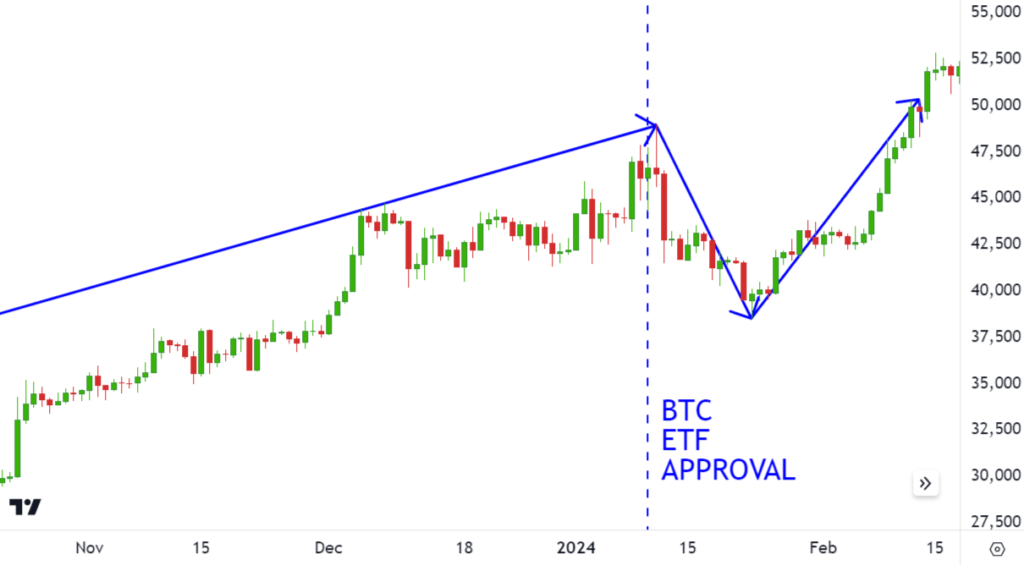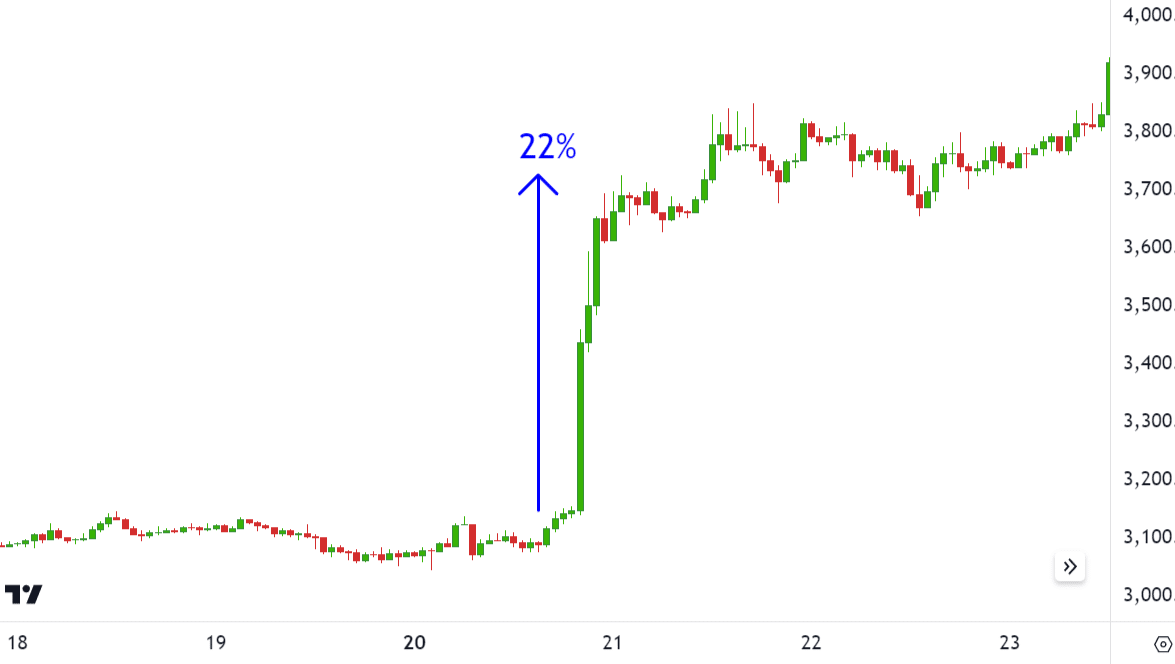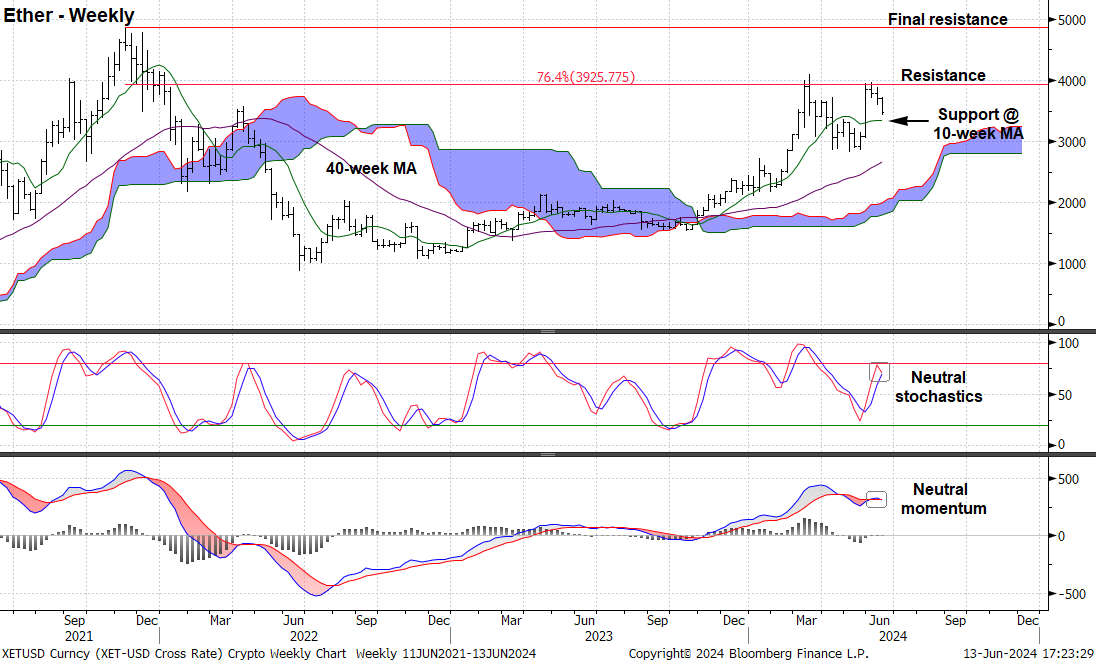
Posted June 14, 2024 at 11:10 am EST.
When the U.S. Securities and Exchange Commission (SEC) approved the 19b-4 forms for eight different spot ether exchange-traded funds (ETFs), the price of ether surged nearly 20% within several hours of the news.
Now ETF applicants are submitting their S-1s, a registration form which needs to be greenlit by the securities regulator before the funds can start trading on exchanges. The SEC’s Gensler alluded to this process being completed by the end of the summer when speaking to the Senate Appropriations Committee on Thursday.
The registrations are being reviewed at a “staff level,” Gensler said, and will still depend on issuers and how responsive they are to any comments they receive. With the ball in the court of ETF issuers, where does the market see the price of ether going before and after the launch?
Investment management firm VanEck, whose application for a spot ether ETF was one of the eight to receive approval on their 19b-4 form, recently raised their 2030 price target for ether to $22,000. But Katie Talati, head of research at crypto asset management firm Arca, said in an email to Unchained that as of late “ether has struggled to establish a strong narrative compared to other layer 1 solutions and the emergence of layer 2 solutions.”
ETH’s Potential Price in the Short-term (Pre-launch)
Short-term, this lack of narrative could give ether a boost — though likely not as high as $22,000 — as traders were under positioned in the asset when the approval announcement hit.
Coinbase Institutional’s trading desk, “has seen increased buying in ether following the 19b-4 approvals,” said David Duong, Coinbase’s head of institutional research, in an email, “It hasn’t been nearly as aggressive as what we saw in bitcoin before spot bitcoin ETFs launched in the US. That leads us to believe that the market is still under positioned.”
For bitcoin, it was a “buy the rumor, sell the news” event because there was so much speculation in the lead up to the January approval of the bitcoin ETFs. While in the case of ether, “traders didn’t sell the news—they bought it,” due to the surprise nature of the approvals, said Glen Goodman, author of “The Crypto Trader,” in an email to Unchained.
Investors should still tread with caution, Katie Stockton’s Fairlead Strategies’ June 10 report states that ether has already given back some of its outperformance to bitcoin since the spot ether ETF news. The analysts foresee bitcoin continuing to outperform ether in the near term, describing their analysis of ether’s weekly MACD and stochastics as neutral, adding that they “will assume a bullish bias once ether clears resistance near $3,925 on a consecutive weekly closing basis.”
Where ETH Could Go Long-term (Post-launch)
After experiencing a pullback post-ETF approval, “bitcoin went on to rally 72% from $39,201 to $67,339, ultimately making a new all-time high price in March of 2024,” said Teddy Fusaro, president at Bitwise, a crypto investment firm that launched a spot bitcoin ETF in the US.
If this were to happen, ether would have to rally more than 35% percent from its current price to reach its November 2021 all-time-high of $4,867, Fusaro said.
While that may be plausible, Arca’s Katie Talati is not convinced that spot ether ETFs will have as substantial of a long-term impact on ether’s price given that institutional demand is not as high for ether as it is for bitcoin.
In a previous interview with Unchained, Ophelia Snyder, co-founder and president of crypto ETP provider 21Shares, alluded to this, saying that institutional knowledge of ether pales in comparison to that of bitcoin. 21Shares manages the 21Shares Ethereum Staking ETP (AETH) in Europe as well as a spot bitcoin ETF in the US known as ARKB,
Talati also noted that “the Grayscale Ethereum Trust, which has $10 billion in assets under management (AUM), will likely also experience consistent outflows and cause daily selling pressure in the Ethereum market.”
A recent report from crypto research firm Kaiko shared a similar sentiment. “Once the ether ETFs launch, it is reasonable to expect selling pressure on ether from likely outflows or redemptions due to Grayscale’s ETHE, which has been trading at a discount between 6% and 26% over the past three months.”
Still, crypto research firm K33’s senior analyst Vetle Lunde in a recent report anticipated that US spot ether ETFs will attract $4 billion in net inflows in their first five months after launch. In a message to Unchained, Vetle explained that he expects roughly 20% of this $4 billion to come from institutional investors, putting their anticipated AUM at $700-800 million.
While some question whether the absence of staking in the ether ETFs will limit investor interest in the funds due to lack of APY (Annual Percentage Yield), Lunde does not see this as an issue, writing that, “99.1% of the AUM in Canadian ether ETFs are held in non-staked products, whereas 97.9% of European AUM sits in non-staked ETPs. This indicates that staking is far from a major issue among ETP investors.”
In April, the Hong Kong Securities and Futures Commission approved the trading of spot ether ETFs along with their bitcoin counterparts. Using Hong Kong’s market as a point of reference, Crypto Is Macro Now author and economist Noelle Acheson wrote in a recent newsletter that, “when/if the ether spot ETFs eventually launch, we should brace ourselves for a disappointing reception.” Acheson bases this prediction on the fact that since these securities began trading in Hong Kong, ether has accounted for less than 15% of the total spot crypto ETF AUM.
Pranav Kanade, VanEck’s digital assets alpha fund portfolio manager, shares this assumption that interest in the spot ether ETFs may not be as explosive as it was with bitcoin, writing to Unchained that “the narratives for bitcoin lined up perfectly, especially in the United States … the stars don’t seem to be aligning as perfectly as they did with the bitcoin ETF.”
Despite this, Kanade said that their bullish 2030 price prediction for ether assumes that ETFs will be a catalyst for further interest into the Ethereum network and its varying applications, such as stablecoins and other tokenized financial assets. “This, in turn, will drive increasing levels of activity on Ethereum or its layer 2 solutions, resulting in a higher amount of ether being burned and a lower overall supply of ether,” Kanade said.
Powered by WPeMatico





